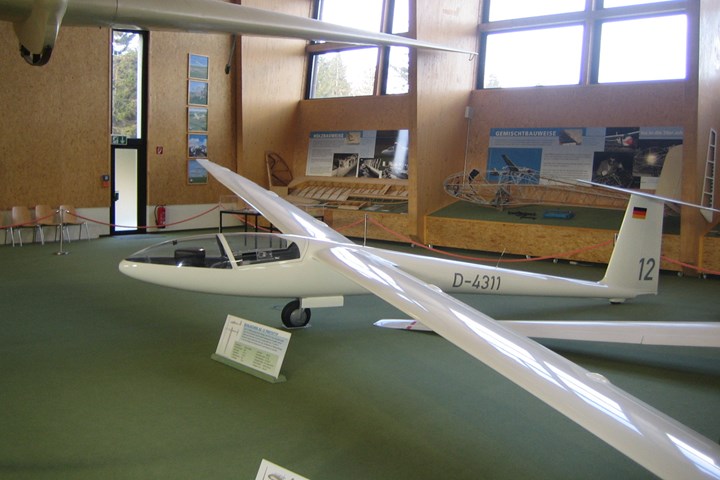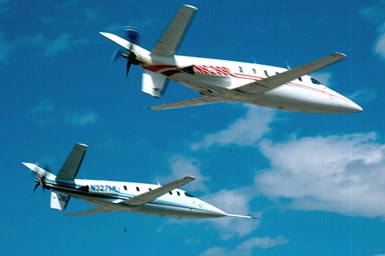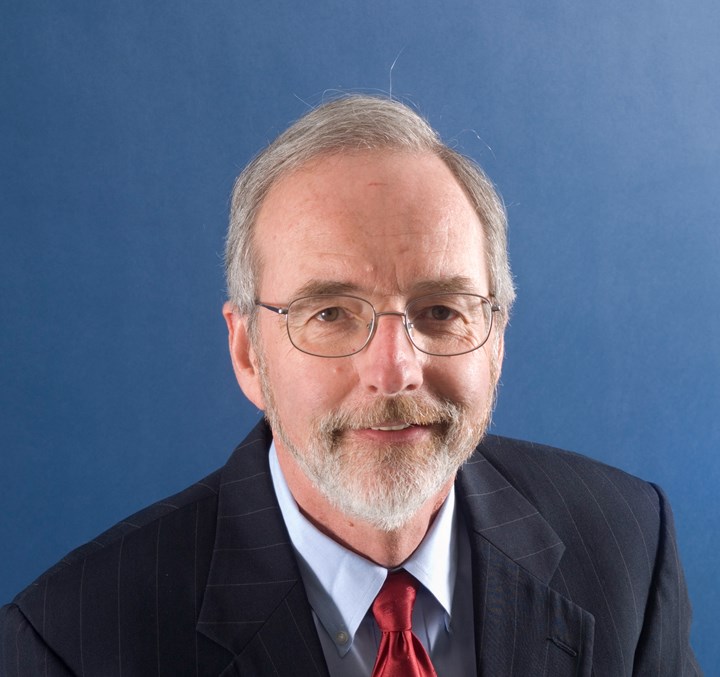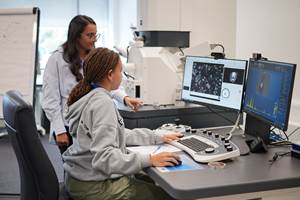
ASW-12 sailplane derived from the “Gummiflügel” prototype. Photo Credit: Wo st 01 / Wikimedia Commons, CC BY-SA 3.0 de, https://commons.wikimedia.org/w/index.php?curid=6634801
As the recently retired owner of Abaris Training Resources Inc. (Reno, Nev., U.S.), I have been very fortunate to experience many developments in the advanced composites and aerospace industries over the last 35 years. I was born into aviation — my father owned a flight school near Charlotte, N.C., U.S., and I learned to fly gliders at the age of 14 and powered aircraft at 16. I first became aware of composite structures when I was a crew member at the World Gliding Championships in 1965 which, at the time, was located at the South Cerney RAF base in England. Eighty-six sailplanes were entered into the competition, but the one that really caught my eye was the only all-composite ship competing, built of fiberglass/balsa core sandwich structures. The D-36, developed in Germany, was sleek and had very long, thin, flexible wings; the Germans nicknamed it the “Gummiflügel,” or “rubber wing.”
In 1976, after some time in the Army and graduate school, I moved to Reno, Nev., U.S. There, I continued to fly sailplanes — and even owned a couple of all-composite versions through the 1990s. The second composite sailplane I owned was all carbon fiber, and it further sparked my interest in these new materials. I also got to watch Bill Lear — famous for the Learjet — and his efforts to develop the all carbon-fiber Lear Fan, which was the first attempt to build an all-carbon fiber pressurized aircraft; this work was done in Reno, where Lear resided.
Unfortunately, Bill Lear died before these prototypes flew. The company never recovered from his loss and closed in 1983. Bill Murphy, a freshly retired Navy fighter pilot and Lear Fan production manager, decided to form a training company he called Abaris Training, beginning with training materials the Lear Fan company had already developed, which he purchased from the bankruptcy trustee for $1.
The new company began by training Navy maintenance personnel on the repair of damaged F-18 carbon fiber wings and tail surfaces; the F-18s were just being introduced to aircraft carrier operations at the time. Abaris Training slowly grew from there. I joined Bill in 1987, became an instructor and met Lou Dorworth, who was teaching tooling classes for Bill at this time. (Lou is still with Abaris to this day!) Bill and I formed a business partnership in 1989. In 1991, Bill suffered a sudden heart attack and passed away; restructuring the company fell to me. Thus was Abaris Training Resources Inc. born, which my wife, Janice, and I owned.
After moving to another training location in Reno, we began focusing on the company’s growth. One of the most difficult things to do, from then to now, was to keep developing and updating the training classes, as advanced composites technology itself was rapidly evolving during the 1990s, and beyond. New classes had to be developed from scratch, existing classes updated and new instructor skills were needed. We also needed input from the outside.
During my first SAMPE meeting in 1989, in Reno, I met a lot of very knowledgeable people who would eventually solve this need, and who have helped me for many years: Dr. Brent Strong, Rik Heslehurst from Australia, Dr. Scott Beckwith and many others.
In 1992, I decided to get involved in the early development of the SAE’s (Warrendale, Penn., U.S.) CACRC (Commercial Aircraft Composite Repair Committee). I learned so much from all of the individuals that I met during those years. Dr. Keith Armstrong from British Airways was one of the early developers of carbon fiber and is said to have created, in 1968, the first carbon fiber parts installed on any airliner, the floorboards for VC-10s. He was also one of the founders of the CACRC. Talking with him was very eye-opening for me and led directly to the many additions and improvements made to Abaris’ training curricula.
That first CACRC meeting, for me, in Denver in the summer of 1992, was also where I met Ginger Gupton, who was representing DuPont and its Kevlar and Nomex materials. Now Ginger Gardiner, she is a senior editor for CompositesWorld, and her vast technical knowledge and detailed articles have been an invaluable source of new information for us for many years. I also can’t forget the tremendous amount of work put into the first and second versions of our current textbook, authored by Ginger, Lou and Greg Mellema — now the director of operations for Abaris — over a number of years, which was, in my opinion, the single best thing that happened for this company. The second edition has become an industry standard, and I am very gratified by that!

Two of the three Lear Fans in flight near Reno, Nevada. Photo Credit: Museum of Flight (Seattle).
In addition, attending many of the technical seminars given at trade shows such as SAMPE and CAMX has been a great source of new information and ideas about changes and updates needed to keep Abaris classes up to date. It takes constant, deliberate effort to keep up with the changes in composites technologies and remains a never-ending quest. Newer developments, such as high-temperature ceramic matrix composites (CMC), nanofibers, 3D composite printing, rapid advancement in thermoplastic composite material technologies and the spread of composites into many non-aerospace applications, are all reasons to continue to seek new information.
Abaris Training started with one five-day hands-on damage repair class. By the time I was in charge, it had two different repair classes and a tooling class. Now, it has 25 different courses, and all of them still include the most important component: hands-on training. The students, even in the most advanced engineering classes, don’t just listen to lectures and watch PowerPoints — they get their hands dirty by building, vacuum bagging, testing and repairing all sorts of carbon fiber, fiberglass and Kevlar parts. They also learn prepreg manufacturing, as well as wet layup techniques, autoclave and oven curing, resin infusion, moldmaking and many different aspects of damage repair.
The most interesting developments I have seen over my almost 40 years in the industry include not only the technical developments in the materials and processes themselves, but also watching the widespread adoption of these materials into different industries and products. From small boats in the late 1940s, to Corvette fiberglass bodies starting in 1953 and early civilian and military aircraft uses produced in the 1960s and 70s, developments quickly spread throughout the aerospace industry and many others. For example, the widespread launch vehicle and spacecraft applications, Formula 1 race cars in the late 1980s, all-composite airliners such as the Boeing 787 and Airbus A350, bicycles, golf clubs, tennis rackets, skis, heavy truck semi-trailers, medical prosthetics and architectural structures — the growth opportunities seem endless, and I have been in a fortunate position to watch a lot of it.
In the near future, continuing improvements will accelerate computer-aided design of structures. New methods are being developed to enable tailoring the exact chemical reactions of the resins in both thermoset and thermoplastic matrix systems, and controlling the details of the curing process in real time. Non-destructive inspection (NDI) techniques are advancing, and we are finally looking at a method of evaluating bondline strength without breaking the bond. Higher strength fibers will continue to be developed and improved. These technologies will set the foundations for applications such as high-pressure cryogenic hydrogen storage systems, which will be light enough to enable practical hydrogen-fueled airliners, trucks, buses and cars.
These are just a few of many examples of what can be done in the very near future, and I am excited to be able to follow these improvements for a long time to come! It has been a rare privilege to accompany this industry through such rapid developments, and, in a small way, to help Abaris add to the skills of more than 26,000 graduates of Abaris Training classes during my time there.
About the Author
Michael Hoke
Michael J. (Mike) Hoke became the president and co-owner of Abaris Training Resources Inc. (Reno, Nev., U.S.), in 1990. He has instructed thousands of students in advanced composite and related technologies since then, and also has a background as an active pilot. He retired from Abaris Training in December of 2021, but is still involved with Abaris on a consulting basis. mjh@abaris.com
Related Content
AMRC Training Centre introduces composites apprenticeship opportunity
With partners McLaren and Teledyne CML Composites, the Training Center will train new composites technicians in South Yorkshire to build up the future industry workforce.
Read MoreZeiss, Imperial College London summer school enhances materials, sustainability learning
Twenty-four next-generation students attended the Imperial College London this August to advance their scientific knowledge, with workshops, lectures, activities and a composites competition.
Read MoreComposites UK launches best practice guide for composites tooling
“Mould Tooling for Fibre-Reinforced Polymer Composites” is latest in Composites UK’s series of good practice guides, available online for free.
Read MoreToray, University of Chicago speed up polymer recycling R&D
A jointly developed multi-scale computational predictive technique can accurately predict viscoelasticity from the chemical structures of polymers, ramping up product maturation.
Read MoreRead Next
Developing bonded composite repair for ships, offshore units
Bureau Veritas and industry partners issue guidelines and pave the way for certification via StrengthBond Offshore project.
Read MoreAll-recycled, needle-punched nonwoven CFRP slashes carbon footprint of Formula 2 seat
Dallara and Tenowo collaborate to produce a race-ready Formula 2 seat using recycled carbon fiber, reducing CO2 emissions by 97.5% compared to virgin materials.
Read MoreVIDEO: High-volume processing for fiberglass components
Cannon Ergos, a company specializing in high-ton presses and equipment for composites fabrication and plastics processing, displayed automotive and industrial components at CAMX 2024.
Read More






















